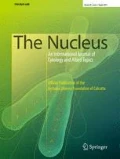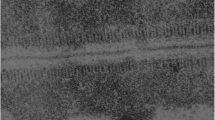Abstract
Scientific cytology and cytogenetics go back to the Nineteenth century. During the last six decades—since the foundation of The Nucleus—numerous breakthroughs in chromosome technologies enabled considerable progress of chromosome biology. Nevertheless, several biological phenomena—a subjective selection is presented in this article—are still poorly understood and await a deeper investigation in future.
Similar content being viewed by others
References
Banaei-Moghaddam AM, Schubert V, Kumke K, Weibeta O, Klemme S, Nagaki K, et al. Nondisjunction in favor of a chromosome: the mechanism of rye B chromosome drive during pollen mitosis. Plant Cell. 2012;24:4124–34.
Birchler JA, Han FP. Meiotic behavior of small chromosomes in maize. Front Plant Sci. 2013;4:505.
Chen ZJ. Genomic and epigenetic insights into the molecular bases of heterosis. Nat Rev Genet. 2013;14:471–82.
Corral JM, Vogel H, Aliyu OM, Hensel G, Thiel T, Kumlehn J, et al. A conserved apomixis-specific polymorphism is correlated with exclusive exonuclease expression in premeiotic ovules of apomictic Boechera species. Plant Physiol. 2013;163:1660–72.
Hsu TC. Human and mammalian cytogenetics. An historical perspective. New York: Springer; 1979.
Ishii T, Karimi-Ashtiyani R, Houben A. Haploidization via chromosome elimination: means and mechanisms. Annu Rev Plant Biol. 2016;67:421–38.
Lermontova I, Rutten T, Schubert I. Deposition, turnover, and release of CENH3 at Arabidopsis centromeres. Chromosoma. 2011;120:633–40.
Maeshima K, Hihara S, Eltsov M. Chromatin structure: does the 30-nm fibre exist in vivo? Curr Opin Cell Biol. 2010;22:291–7.
Mau M, Corral JM, Vogel H, Melzer M, Fuchs J, Kuhlmann M, et al. The conserved chimeric transcript UPGRADE2 is associated with unreduced pollen formation and is exclusively found in apomictic Boechera species. Plant Physiol. 2013;163:1640–59.
Pecinka A, Abdelsamad A, Vu GT. Hidden genetic nature of epigenetic natural variation in plants. Trends Plant Sci. 2013;18:625–32.
Sanei M, Pickering R, Kumke K, Nasuda S, Houben A. Loss of centromeric histone H3 (CENH3) from centromeres precedes uniparental chromosome elimination in interspecific barley hybrids. Proc Natl Acad Sci USA. 2011;108:E498–505.
Schubert I. Alteration of chromosome numbers by generation of minichromosomes—is there a lower limit of chromosome size for stable segregation? Cytogenet Cell Genet. 2001;93:175–81.
Schubert I, Oud JL. There is an upper limit of chromosome size for normal development of an organism. Cell. 1997;88:515–20.
Taylor JH, Woods PS, Hughes WL. The organization and duplication of chromosomes as revealed by autoradiographic studies using tritium-labeled thymidinee. Proc Natl Acad Sci USA. 1957;43:122–8.
Tjio JH, Levan A. The chromosome number of man. Hereditas. 1956;42:U1–6.
Vu GHT, Cao HX, Reiss B, Schubert I. Plant genomes may shrink via deletion-biased DNA double-strand break repair. New Phytol. 2017;214:1712–21. doi:10.1111/nph.14490.
Wang X, Moazed D. DNA sequence-dependent epigenetic inheritance of gene silencing and histone H3K9 methylation. Science. 2017;356:88–91.
Author information
Authors and Affiliations
Corresponding author
Additional information

In Honour of Prof AK Sharma, the Founder and Editor-in-Chief of the Nucleus
Rights and permissions
About this article
Cite this article
Schubert, I. Some past developments and open questions in understanding the biology of nucleus. Nucleus 60, 247–249 (2017). https://doi.org/10.1007/s13237-017-0217-4
Received:
Accepted:
Published:
Issue Date:
DOI: https://doi.org/10.1007/s13237-017-0217-4




